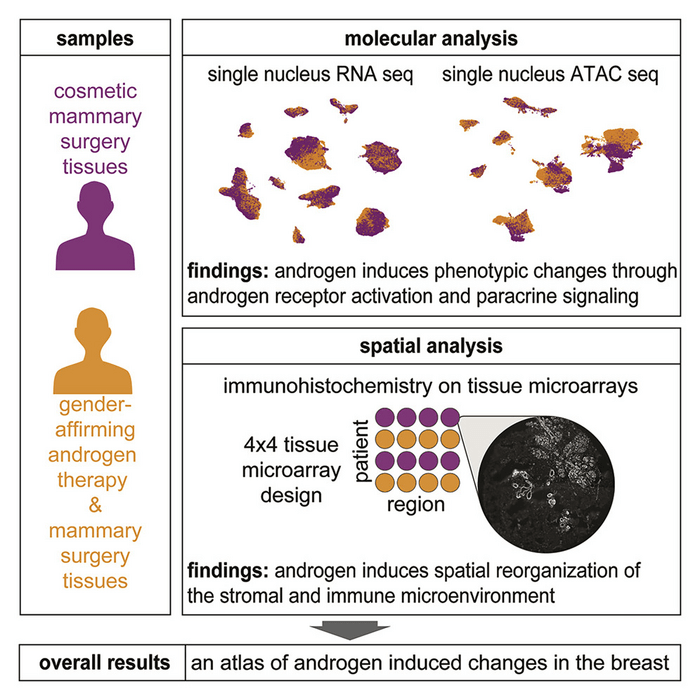For the first time, researchers examine the effects of gender-affirming androgen therapy on breast tissue in transgender men with single-cell resolution. Their results give an unprecedented look into the changes that occur as a result of gender-affirming androgen therapy—a common and highly effective form of transgender care—but also have implications for the treatment of breast cancer across all populations. Notably, they show that gene expression in breast cells is silenced, and male gene programs are activated. This work appears in the journal Cell Genomics on March 8.
“Many of the gene-expression changes induced by androgen therapy were also consistent with male-specific sex biases uncovered when comparing breast tissues and other organs from cis-gender males and females,” write the authors. This includes the increased expression of the gene CUX2, which has the highest expression in the prostate as well as elevated levels in cis-male liver and breast tissues compared to cis-female tissues.
The researchers obtained breast tissue from mastectomies of transgender men who had undergone androgen therapy and compared them to breast tissue from cis-gender women obtained from cosmetic mammary surgery. For each tissue type, they characterized the associated changes in gene expression and cell-cell interactions while taking into account the spatial profile of the cells.
In the trans-male tissues, they found that cells expressing hormone receptors had been reprogrammed by androgens, and these cells then passed on the effects to nearby cells through paracrine signaling relays. The trans-male cells were silenced compared to cis-female cells, showing fewer unique molecular identifiers and genes. While cis-female cells showed gene expression associated with growth factors and mammary gland development, trans-male cells showed that associated with fatty acid metabolism and calcium signaling.
Within the cis-female samples, the researchers looked at those from both pre- and post-menopausal women. In comparison to the trans-male tissue, the differences between these two tissue types were miniscule, indicating that changes in the trans-male breast most likely occur not simply due to cessation of estrogen production by the ovaries but also directly due to androgens.
A close look at the effect of androgens on breast tissue is also useful for understanding the treatment of breast cancer. It is already known that breast cancer rates are lower in transgender men, and recent studies have shown that activation of androgen receptors can have antitumor activity in certain breast cancers.
In this study, the researchers found that androgen therapy suppressed the expression of genes involved in BRCA-mutant breast cancer. “Overall, this indicates androgen receptor activation may be a valid preventive or therapeutic strategy for ER+ breast cancer, and, in accordance, clinical trials testing androgen receptor activation in this subtype have been implemented,” write the authors.
###
This work was supported by the Canadian Institutes of Health Research, the National Health and Medical Research Council of Australia, Movember and National Breast Cancer Foundation Collaboration Initiative, Hospital Research Foundation grants, the National Institutes of Health, the Department of Defense, NBCF, the Fashion Footwear Chartable Foundation of New York Inc., and the Margie and Robert E. Peterson Foundation.
Cell Genomics, Raths and Karimzadeh et al. “The molecular consequences of androgen activity in the human breast” https://www.cell.com/cell-genomics/fulltext/S2666-979X(23)00032-0
Cell Genomics (@CellGenomics), is a new Gold open access journal from Cell Press publishing multidisciplinary research at the forefront of genetics and genomics. The journal aims to bring together diverse communities to advance genomics and its impact on biomedical science, precision medicine, and global and ecological health. Visit https://www.cell.com/cell-genomics/home. To receive Cell Press media alerts, please contact press@cell.com.
Journal
Cell Genomics
DOI
10.1016/j.xgen.2023.100272
Method of Research
Experimental study
Subject of Research
People
Article Title
The molecular consequences of androgen activity in the human breast
Article Publication Date
8-Mar-2023

















